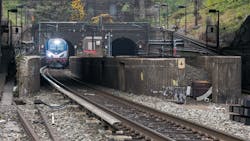FTA releases updated project ratings for CIG Program projects
The Federal Transit Administration (FTA) released updated rankings for projects in the Capital Investment Grants (CIG) Program last week. The information is typically tied to the president’s budget for the year. However, the Bipartisan Infrastructure Law provides up to $23 billion to the CIG Program over five years – double current levels of funding – which prompted FTA to release the rankings ahead of the budget.
Projects must earn and maintain a ranking of “Medium” or higher to be eligible for the federal funding provided through the CIG Program. FTA notes the rankings are required at multiple points in the CIG Program process and are based on a set of statutorily-defined project justification and local financial commitment criteria.
Six projects carry new or updated rankings. The three projects to be rated for the first time include the ART North South Corridor BRT in San Antonio, Texas, which received a Medium-High rating; the Innovation Corridor BRT in Memphis, Tenn., which received a Medium rating and the UTA Mid-Valley Connector BRT in Salt Lake City, Utah, which received a Medium-Low rating.
The RapidRide I Line BRT and RapidRide Roosevelt J Line BRT, both in Seattle, Wash., underwent a new rating process, but maintained previous ratings of Medium-High for the RapidRide I Line BRT and High for the RapidRide Roosevelt J Line BRT.
The Hudson Tunnel Project, which earned a Medium-Low rating during its last evaluation, was given an updated ranking of Medium-High. The project is currently in the project development stage of the CIG Program and the updated project information sheet on FTA’s website notes the overall project cost and requested CIG funds both increased from its last rating, but the finance charges decreased and the CIG share remained constant at 44 percent.
FTA says it worked with the Port Authority of New York and New Jersey (PANYNJ) and the other project partners as they seek to advance the Hudson Tunnel Project through the program. FTA notes PANYNJ must complete several CIG program requirements before the project is eligible to advance to the engineering phase of the CIG process.
“Well-planned, large public transportation projects can transform lives and entire regions by reducing commute times, increasing safety, opening economic opportunities, reducing emissions and making travel more affordable – and thanks to President [Joe] Biden’s Bipartisan Infrastructure Law, we can help more communities deliver these benefits,” said U.S. Transportation Secretary Pete Buttigieg. “For example, the Hudson Tunnel Project will enable a safe, comfortable commute for hundreds of thousands of Americans currently traveling through a tunnel that was built more than 110 years ago.”
The CIG Program has helped with the construction or expansion of more than 150 transit projects around the United States. Modes to benefit under the program have included heavy rail, commuter rail, light rail, streetcar and bus rapid transit.
“Communities all across our nation are dreaming big and making concrete plans, putting in the time and planning to create transit projects that help people get to work, to shopping, and to visit family and friends more quickly, easily and safely,” said FTA Administrator Nuria Fernandez. “FTA is proud to support those efforts through the CIG program and thankful to Congress and the Biden-Harris Administration for giving us the tools we need to do so.”
About the Author

Mischa Wanek-Libman
Group Editorial Director
Mischa Wanek-Libman is director of communications with Transdev North America. She has more than 20 years of experience working in the transportation industry covering construction projects, engineering challenges, transit and rail operations and best practices.
Wanek-Libman has held top editorial positions at freight rail and public transportation business-to-business publications including as editor-in-chief and editorial director of Mass Transit from 2018-2024. She has been recognized for editorial excellence through her individual work, as well as for collaborative content.
She is an active member of the American Public Transportation Association's Marketing and Communications Committee and served 14 years as a Board Observer on the National Railroad Construction and Maintenance Association (NRC) Board of Directors.
She is a graduate of Drake University in Des Moines, Iowa, where she earned a Bachelor of Arts degree in Journalism and Mass Communication.
